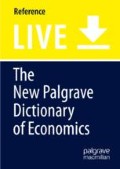Abstract
This article discusses difference-in-differences (DID) estimators, which are commonly applied in evaluation research. In particular, the discussion focuses on (a) motivation, definition and interpretation of DID estimators, (b) conditions under which DID estimators are valid, (c) data requirements to compute DID estimators, (d) representative applications of DID estimators in the empirical economics literature, (e) extensions of DID estimators, and (f) a simple indirect test to assess the validity of these estimators.
This chapter was originally published in The New Palgrave Dictionary of Economics, 2nd edition, 2008. Edited by Steven N. Durlauf and Lawrence E. Blume
Bibliography
Abadie, A. 2005. Semiparametric difference-in-differences estimators. Review of Economic Studies 72: 1–19.
Angrist, J.D., and A.B.. Krueger. 1999. Empirical strategies in labor economics. In Handbook of labor economics, ed. O. Ashenfelter and D. Card, Vol. 3A. Amsterdam: North-Holland.
Ashenfelter, O., and D. Card. 1985. Using the longitudinal structure of earnings to estimate the effects of training programs. Review of Economics and Statistics 67: 648–660.
Athey, S.C., and G.W. Imbens. 2006. Identification and inference in nonlinear difference-in-difference models. Econometrica 74: 431–498.
Blundell, R., and T. MaCurdy. 1999. Labor supply: A review of alternative approaches. In Handbook of labor economics, ed. O. Ashenfelter and D. Card, Vol. 3A. Amsterdam: North-Holland.
Card, D. 1990. The impact of the Mariel Boatlift on the Miami labor market. Industrial and Labor Relations Review 44: 245–257.
Card, D., and A.B.. Krueger. 1994. Minimum wages and employment: A case study of the fast-food industry in New Jersey and Pennsylvania. American Economic Review 84: 772–793.
Garvey, G.T., and G. Hanka. 1999. Capital structure and corporate control: The effect of antitakeover statutes on firm leverage. Journal of Finance 54: 519–546.
Gruber, J., and J. Poterba. 1994. Tax incentives and the decision to purchase health insurance: Evidence from the self-employed. Quarterly Journal of Economics 109: 701–733.
Heckman, J.J., H. Ichimura, and P.E. Todd. 1997. Matching as an econometric evaluation estimator: Evidence from evaluating a job training programme. Review of Economic Studies 64: 605–654.
Meyer, B.D. 1995. Natural and quasi-experiments in economics. Journal of Business & Economic Statistics 13: 151–161.
Meyer, B.D., W.K. Viscusi, and D.L. Durbin. 1995. Workers’ compensation and injury duration: Evidence from a natural experiment. American Economic Review 85: 322–340.
Author information
Authors and Affiliations
Editor information
Editors and Affiliations
Copyright information
© 2008 The Author(s)
About this entry
Cite this entry
Abadie, A. (2008). Difference-in-Difference Estimators. In: The New Palgrave Dictionary of Economics. Palgrave Macmillan, London. https://doi.org/10.1057/978-1-349-95121-5_2593-1
Download citation
DOI: https://doi.org/10.1057/978-1-349-95121-5_2593-1
Received:
Accepted:
Published:
Publisher Name: Palgrave Macmillan, London
Online ISBN: 978-1-349-95121-5
eBook Packages: Springer Reference Economics and FinanceReference Module Humanities and Social SciencesReference Module Business, Economics and Social Sciences

